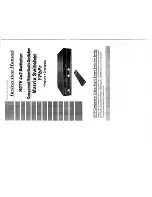
TMD-Display One
Technical Support:
http://zennioenglish.zendesk.com
34
Illumination Modes) depend on either one object or the other. However, if
“
LED Illumination Control (All Buttons)
” (section 2.3.1) has been set to
“state-dependent (where available)” only the short press object will be
considered
Dimmer
: short-pressing one of the two buttons will make TMD-Display send
a switch-on order to the bus, while doing so on the other button will make it
send a switch-off order. Long presses will make it send a step dimming order
(the value of which is configurable) to make a dimmer increase or decrease
the light level (and a stop order as soon as the user releases the push
button). It is possible to configure which button does what.
Under a “
state-dependent
” LED illumination (see ANNEX I: LED Illumination
Modes), the LED of the corresponding button will remain on/off according to
the current state of the dimmer (i.e., according to whether the on/off status
object from the dimmer sends the value “0” or “1” and on the light level, which
should be reported through the proper objects from the dimmer to TMD-
Display). On the other hand, under a “
state-dependent (both LEDs)
” LED
illumination, both of them will remain on or off is depending on whether the
dimmer is “on” or “off” and whether the light level is greater than 0% or not.
Shutter
: this option permits making use of the two buttons to control a shutter
actuator connected to the bus. Two alternative control methods are possible:
Standard: a long press will make the device send to the KNX bus an order
to start moving the shutter (upwards or downwards, depending on the
button), while a short press will make it send a stop order (which will be
interpreted as an order to step up or to step down –depending on the
button– if the shutter was not in motion and such function is available).
Hold & Release: as soon as the button is held, the device will send the
KNX bus an order to start moving the shutter (upwards or downwards,
depending on the button). Once the button is released, it will send an order
to stop the shutter.
The “
state-dependent
” and “
state-dependent (both LEDs)
” LED
illumination modes are not available for this function (only the “
regular
” and
“
dedicated object
” LED illumination are available). See ANNEX I: LED
Illumination Modes for details.
















































